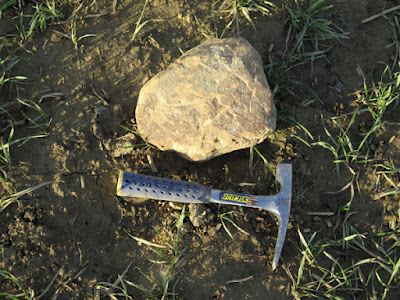Arriving at the eastern outskirts of Todwick on the public footpath from Axle Lane, with my pockets full of pebbles that I had collected from the remains of Quaternary deposits that are found in this part of Rotherham, I made my way through the village on the path to Wales.
The footpath here again runs alongside a ploughed field, at the edge of a housing estate, before heading south-south-west towards a small brook, which flows from the higher ground formed by the Mexborough Rock to the east.
This area of land is marked as glacial till on the British Geological Survey map and, within a few seconds of starting off along this path, I encountered numerous light brown pebbles of a type that I had seen on the first leg of my walk – one of which I broke open with my Estwing hammer with some difficulty, to reveal fine grained Carboniferous sandstone.
Working my way along the path across the muddy field, where an unidentified crop was in its early stages of growth, I could easily have collected as many rocks that I already had on my person - and which were starting to weigh me down.
Having been very glad that I had put my walking boots on, I came across a few more very interesting rocks - including a large piece that had apparently been previously collected and set aside next to a fence post at the end of the path.
On its weathered surface, its grey and siliceous appearance reminded me of chert but, after many attempts to break it open, there is no conchoidal fracture - which is typical of the chert from the Carboniferous limestone that I am familiar with. In places, the fresh surface of the sample has orange staining, suggesting localised concentrations of iron bearing minerals.
At the same locality, I found another equally mysterious rock, composed of loosely interlocking pale green/grey crystals and with many vesicle like voids. When tested with hydrochloric acid, it effervesced moderately and it again proved exceedingly difficult to break.
Carrying along the path to Wales, I encountered vast numbers pebbles of Carboniferous sandstone and red and brown quartzite, amongst other rocks, but by now I had stopped collecting these. By the time that I reached the path that turned west to Storth Lane, I had left behind the patch of till and pebbles in the soil were now very infrequent.
On this path, I collected my last rock of the day, taken from a small erratic that was lying isolated in a field and that I guessed was some kind of coarse sandstone, judging by its surface texture, although it has a colour that is similar to some of the Permian dolomitic limestones that outcrop further to the east.
When examining a piece at home, I tested it with hydrochloric acid test but there was no reaction and it would not scratch with my steel knife, which suggested that it was composed essentially of quartz grains; however; examining it with a hand lens, the coarse angular grains are not clear quartz, but an opaque pale cream mineral that, with some rounded grains, are set in a similarly coloured matrix.
Finally arriving in the centre of Wales, I stopped to have another look at an unusual feature that I had discovered a few years earlier, when investigating its mediaeval church and other historic buildings in the oldest part of the village.
On the west wall of an outbuilding to The Beeches on Manor Road, a blocked doorway has jambs made of Rotherham Red sandstone and, within one of these, a couple of large unusually shaped embedded fragments are weathering out of the stone.
The only inclusions that I have seen in the Rotherham Red sandstone are ironstone pebbles, which are sometimes concentrated into conglomeratic beds, and I wondered if these might possibly be pieces of fossilised bone.
Being set in the wall of a private property next to a listed building, I obviously couldn't consider trying to remove them, but I think that a palaeontologist would be interested in seeing them in situ. For now though, along with many of the specimens that I collected on a very enlightening day, they remain a mystery.
 |
| An inclusion in Rotherham Red sandstone |














No comments:
Post a Comment